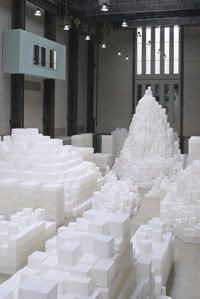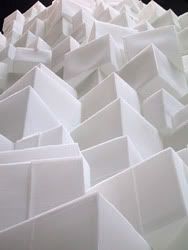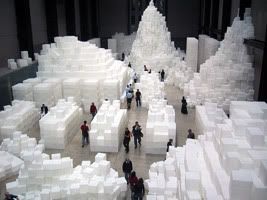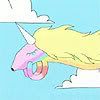Saturday, April 21, 2007
Art Event: The Mandrake, 4/7/07
It was an enjoyable production, with lots of humor. Very funny. I really liked it. I liked how the introduction was set up as a band of travelling players unpacking and parading, especially the trapdoor gag where cast members take out their costumes, and then a signpost, and then the musicians.
Monday, April 2, 2007
Art event: Visit to the Walters Art Museum
Barye lived between 1796 and 1875, and is most well known for his bronze sculptures of animals. Most of the animals in his sculptures are in action in some way-- most often hunting or being hunted. There were tiger hunts, there were lion hunts, there were stag hunts, there were bear hunts. There were bears attacking stags, dogs attacking bears, tigers attacking crocodiles, and snakes attacking tigers.
They were all variations on a theme, to say the least.
He was very good at what he did: in the hunting scenes, riders often look like they're about to fall off their horses. He was excellent at capturing motion and action.
What was very interesting to me was that they also displayed a variety of his paintings, in oil and watercolors, which were, to me at least, sweeter. It was a very nice break from all the man vs. nature captured in bronze. The paintings still always involved animals, but it was more likely that it was a lion trotting along a path, or a tiger rolling around on its back. However, Barye never really left France, never really got to see these exotic animals in their natural habitats. He studied and sketched them at the Jardin des Plantes, and so often wound up painting a lion trotting along a path... in the French countryside.
In fact, I attended this exhibit with my mother, and when we saw the lion tortting along the path in the French countryside painting, she exclaimed, "Someone better call the zoo, quick! That lion's escaped!" She didn't even need to read the wall text to see that the lion was out of place.
Installation proposal
The den will most likely be quilts over a wire frame, the outside treated (with paint?) to look like rock and dirt, evoking animal-made safe space. The inside will still be quilts, evoking human-made safe space.
Sketches:
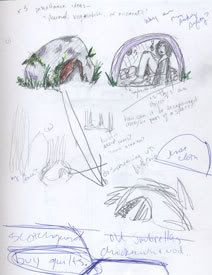
(click for big!)
What is still up in the air is the speakers idea.
My main idea is to create an animal den, something that the viewer/participant has to crawl into (or otherwise change their body shape in which to enter).
The den will be created to be a safe space, as it will have one entrance/exit. It will also incorporate more than one sense in that it will be more of an experience than just looking at something. One can look at it, but one can also enter it, and the experience will be "fleshed out" in that I'm planning on concealing speakers inside that will play nature sounds and other white noise.
I'd like to place this by the mass of forsythia by Monty, close enought that the forsythia become part of the work by overlapping it.
Coming soon:
Saturday, March 31, 2007
Art Event: Colby Caldwell's "Last Lecture"
"The Last Lecture Series brings your favorite professors into the
limelight and asks them what they would want to share if they knew
that this was indeed their 'last lecture' (death, retirement..
whatever.. the last)."
Colby Caldwell's Last Lecture was entitled "From Molly Hatchet to Aphex Twin in Four haircuts (kinda)" (he'd changed a lot at the last minute, apparently.)
It was, more or less, about how the veneration of the DJ-- a person choosing already existing music and creating things with it, as opposed to a working musical artist-- and the rise of rave culture changed his views about art. He also discussed recorded sound versus live performance (in the context of music), and how he went from listening to Molly Hatchet, then Pink Floyd, then Joy Division, then The Cure, and then Aphex Twin. It somehow all fit together, I swear; the lecture was incredibly engaging (especially for me, as I relate to music in many of the same ways).
Wednesday, March 28, 2007
Reading: "Introduction: Site-specifics"
I do understand that spaces can be read as different places and locations depending on their use, and how they are used defines them. An artist can take advantage of the means of defining a space for their own purposes.
However, the author did not have to explain it in such a convoluted manner.
Saturday, March 24, 2007
Reading: "But is it installation Art?"
Rather, the best installation art is marked by a sense of antagonism towards its environment, a friction with its context that resists organisational pressure and instead exerts its own terms of engagement.
This again asserts the definition of installation art creates an environment, and that the experience isn't totally about the works that are on display (if there are any works on display) but about the viewer and how they interact with their environment. However, interactivity isn't really defined as the viewer pushing a button or whatever; interactivity with an installation can be as subtle as the viewer having to move around things. (It doesn't have to be, of course.)
I think that this quote is going back to "The Museum Problem" and dealing with the institutionality of galleries, and the writer thinks that installation art should define itself by defying the institution or something like that, but I think that installation art can work as an addition to its surroundings, rather than struggling with its surroundings.
Tuesday, March 6, 2007
Reading: "The Museum Problem"
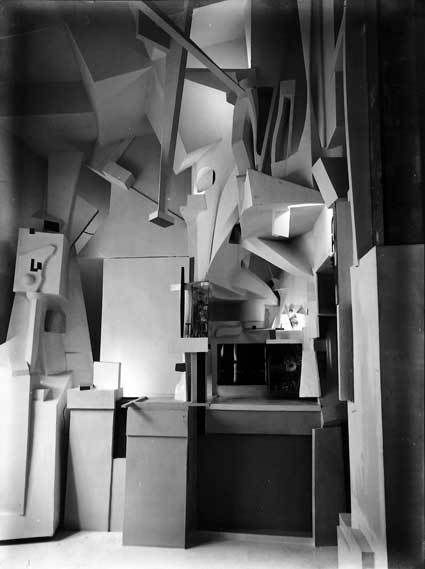
Merzbau, Kurt Schwitters 1923-1948.
This piece creates a more direct relationship to the viewer in that the viewer is not a passive viewer, but immersed in the presence of this room and house. It "activates" the viewer by being made up of many complex pieces that need to be taken in individually, and then taken in in relationship to the surrounding pieces, then in relationship to the whole, then in relationship viewer. It's complex and absorbing viewing that surrounds the viewer and creates an unique experience.
The piece defies galleries and other insitutions by being in the artist's house, and did not require an initial association with a museum. Also by being in the artist's house, it tries to integrate art with the everyday, even though the shapes of which it is made certainly don't look everyday.
Installation art
Sunday, March 4, 2007
"diorama" on display
This piece is an homage to Robert Rauschenberg, Jasper Johns, and their relationship. Interestingly enough, though these two men were lovers, and did help each other with conceptual ideas, they managed to keep their art stylistically separate. I'm interested in an art work's context, because art is never created in a vacuum. This box appropriates and unites their distinctive imagery: Rauschenberg's "Bed" and "Monogram"; Johns's "White Flag" and "Target".
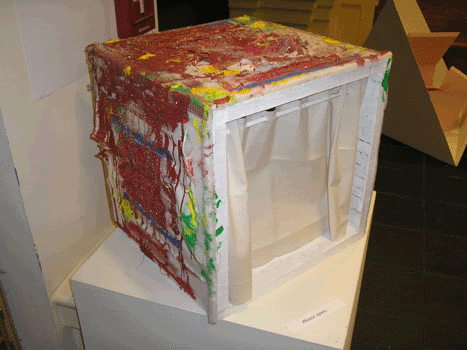
Thursday, February 22, 2007
Art Event: S-E-X-Oh!, 2/17/07
However, I think that there were one or two points of the play that could be improved, that I felt threw me out of the flow of watching the performances a little bit. The first one was the Spanish. I knew that all of the performers would be Latina so I figured that there would be Spanish in the play, I definitely agree with that. However, usually when there is another language in a predominantly English-language performance, there tends to be enough context surrounding the use of the second language for non-speakers of that language to understand the usage and follow along. That was mostly true in S-E-X-Oh!, but there were some times that it wasn’t and I felt left out. (There were other people in the audience laughing along, but they obviously had a better grasp of Spanish than I.)
So, in conclusion, I felt that the performers presented their material well and engagingly, resulting in an enjoyable performance.
Tuesday, February 13, 2007
Hope Chest Concept Statement
The box (approx. 10" x 10" x 10") will be enclosed on all sides except for one; on this final side will be a black curtain that the viewer moves aside to see inside the box. Rauschenberg will be on the outside, that is, the outside of the box will be covered in cloth and paint echoing Rauschenberg's "Bed". The interior will be white paint over newspaper, in homage to Johns's "White Flag". There will be a tiny little sheep inside, like one of Rauschenberg's combines in minerature, but instead of it wearing a tire it will be wearing Johns's famous "Target" image, except in three dimensions.
Also, I'd really like the box to be illuminated from the inside. Both of them used lightbulbs, flashlights, and other electrical light imagery, so I feel like that would be important to include. I also feel like the light would intruige the viewer, and make them more inclined to pull aside the curtain and look inside. It also serves the very practical purpose of illuminating the interior to make it easier to see.
I feel that the piece can reflect their relationship, because the imagery is separate, it is united by virtue of being a part of the same object.
This entire project should have one keep in mind that art is never created in a vaccuum. An artist is affected by everything they experience, whether that experience is the politics and culture of the time, as it is reflected in Johns's and Rauschenberg's artwork, or one's relationships with other people.
Saturday, February 10, 2007
Lecture: John Baldessari, 2/7/07
I really enjoyed the lecture on John Baldessari. I had heard the name before, and had been shown examples of his work (some of the Blasted Allegory) in another art class, as examples of forcing narrative by sequencing images and words, based on the preconstructed way that we read and how we assume that images placed next to each other are related.
I thought it was very interesting how he played with preexisting thought patterns (like the creation of narrative), and constructions like linguistics and the connecting of words with images. I also found it interesting how he played with art's "basic conditions"-- wondering if art required a viewer, like with "This image is not to be looked at"; if art needs to work on more than one level, as in "A work with only one property"; and the presence or lack thereof in the work of art versus the viewer/reader as producer of content. I also liked his concept of "right" versus "wrong" art, as displayed in some of his photographs, that the art requires the belief of the viewer that the work is art to become art.What I liked best about his art was the irony and humor involved within it. Often art can be either Serious Business™ and therefore accepted by the art world, or it can be humorous and therefore not taken as seriously as Serious Business™ art because the humorous art is seen only as light amusement. Baldessari's art was humor and Serious Business™ at once because it was questioning the art world's conventions using humor and irony.
Tuesday, January 23, 2007
Reading 1: "Extended and Prosthetic Bodies"
It seems that using "the body" as art automatically sets a subject that the art addresses, whether it is personal space, or relations between people or between a person and his or her environment, or what have you. By starting the work with people, it becomes about people in some way. It makes perfect sense that it does so, however. As people, we see the world in terms of ourselves, so it makes sense that if the body is used as a medium or vehicle for a work, then the work, in turn, becomes about the body. I just find it interesting that other more traditional mediums are less charged. For example, if one were to paint a still life, the audience won't immediately assume that the artist was making a statement about using paint (unless, of course, that was the artist's intent). Maybe these other, more traditional, mediums are less charged than the body simply because they are more traditional and have the weight of a few thousand years of history behind them; maybe because we are humans and possess bodies, it is more difficult for us to witness someone else do something to their own bodies.
